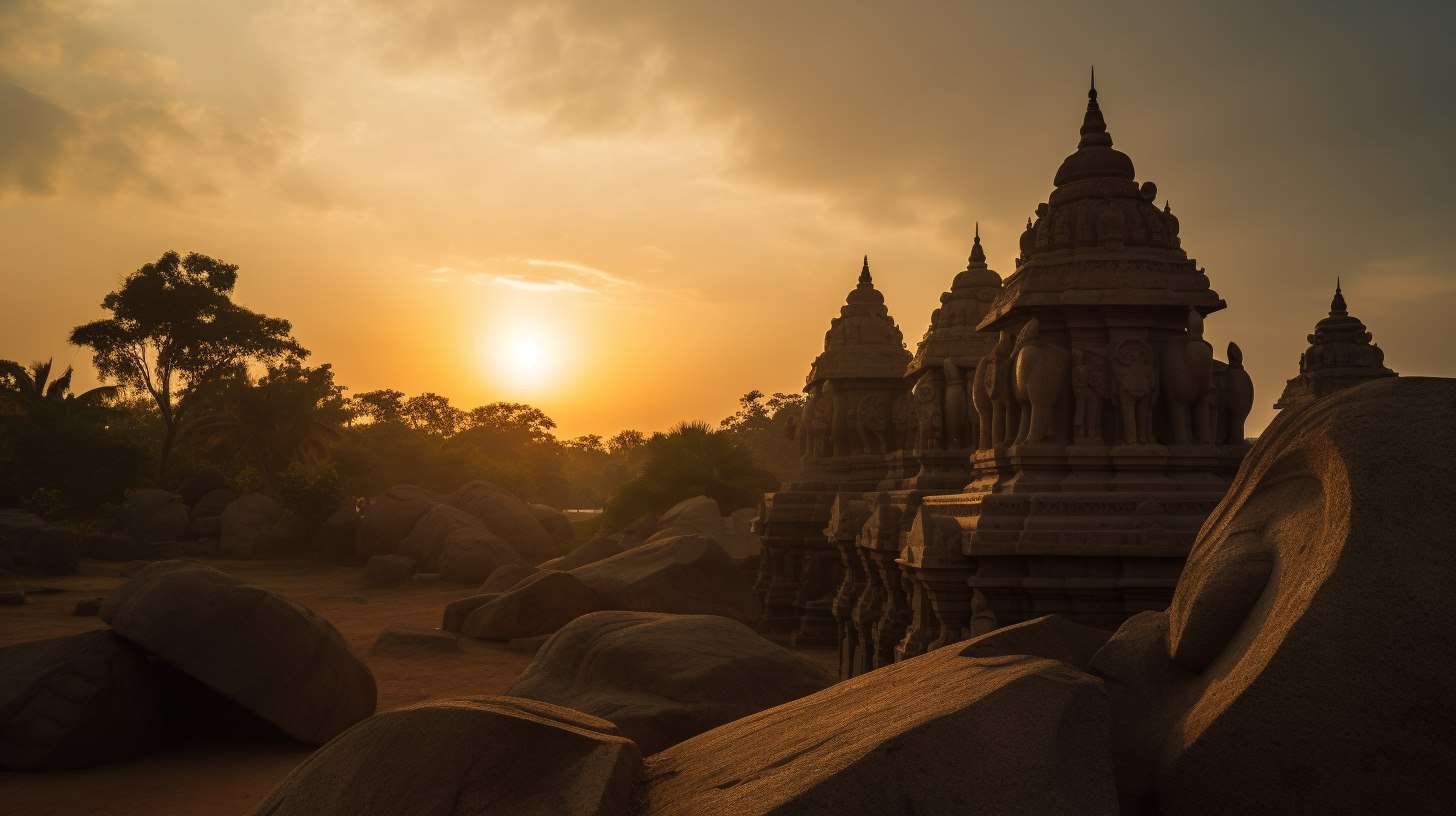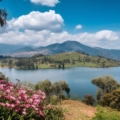Mahabalipuram, nestled on the Coromandel Coast of India, boasts a rich tapestry of history and artistry. The enigmatic allure of this ancient town beckons travelers from across the globe, offering a mesmerizing journey through time and stone.
With roots tracing back to the 7th and 8th centuries, Mahabalipuram, also known as Mamallapuram, serves as a testament to the Pallava dynasty’s architectural prowess. The site holds immense significance, embodying a confluence of history, spirituality, and craftsmanship.
The Monuments of Mahabalipuram
Shore Temple
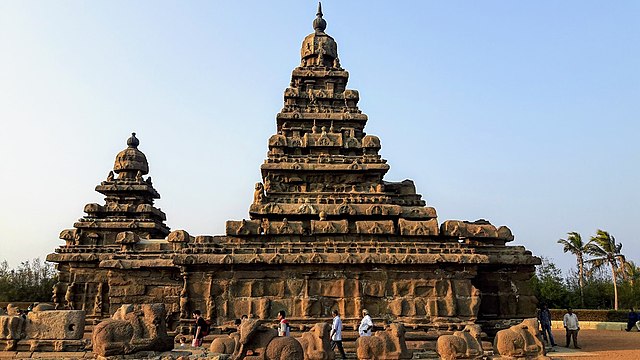
Standing majestically against the backdrop of the Bay of Bengal, the Shore Temple stands as a testament to Dravidian architecture. This UNESCO World Heritage Site, dedicated to Lord Shiva, is an exemplary fusion of granite and skilled craftsmanship.
Pancha Rathas (Five Rathas)
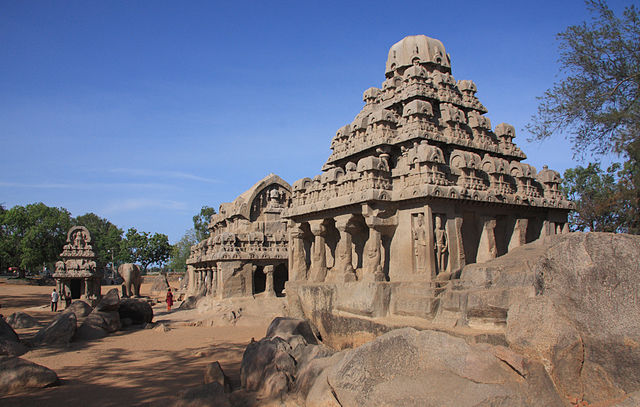
The intricately carved monolithic structures of the Pancha Rathas showcase a symphony of architectural styles, each named after the Pandavas from the epic Mahabharata. These standalone chariot-shaped shrines exhibit unparalleled craftsmanship.
Descent of the Ganges
The magnificent bas-relief sculpture, known as the Descent of the Ganges, captivates with its intricate details. Carved on two massive boulders, it depicts scenes from Hindu mythology, showcasing gods, humans, and animals in a divine narrative.
Arjuna’s Penance
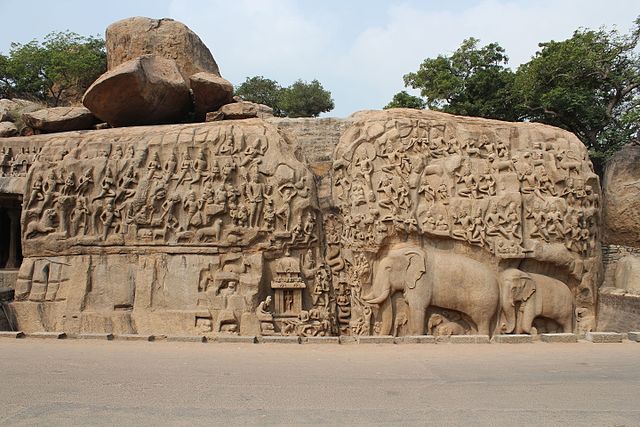
A colossal rock-cut relief, Arjuna’s Penance, depicts the legend of Arjuna, showcasing his austere penance to obtain Lord Shiva’s weapon. This masterpiece of artistry showcases intricate carvings portraying various life forms and celestial beings.
Architectural Brilliance
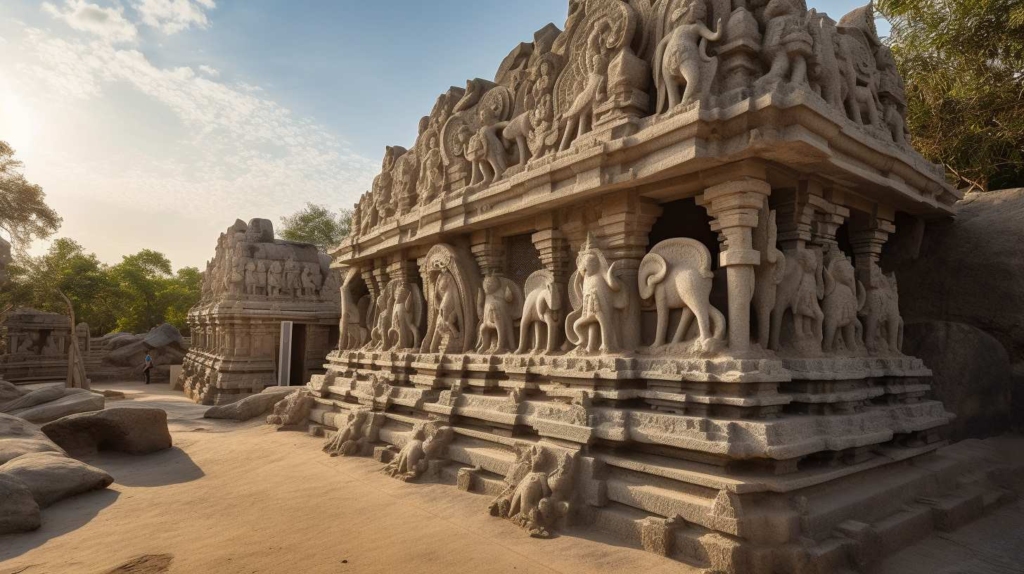
The architectural brilliance of Mahabalipuram reflects the grandeur of Dravidian architecture, characterized by intricate carvings, mandapas, and gopurams. The precision and attention to detail in each structure showcase the mastery of ancient craftsmen.
Historical Significance
Mahabalipuram’s UNESCO World Heritage Site status underscores its global significance. Beyond its artistic marvels, the town served as a vital seaport, facilitating trade with distant lands, and leaving an indelible mark on cultural exchanges.
Tourist Experience
Visitors to Mahabalipuram are greeted with a treasure trove of experiences, from exploring architectural wonders to engaging with local artisans crafting exquisite stone sculptures. The vibrant cultural milieu adds depth to the tourist experience.
Preservation Efforts
While time and environmental factors pose challenges, concerted efforts towards conservation and restoration ensure the preservation of Mahabalipuram’s heritage. These endeavors strive to maintain the site’s authenticity for future generations.
Mahabalipuram’s Cultural Legacy
The influence of Mahabalipuram extends beyond its historical confines, leaving an indelible mark on contemporary art and architecture worldwide. Its timeless allure continues to inspire artists and architects globally.
Conclusion
In the tapestry of India’s cultural heritage, Mahabalipuram stands as an irreplaceable thread. Its ancient stones echo tales of artistic brilliance, spiritual devotion, and historical significance. As we trace our steps back from this mesmerizing journey through time and stone, Mahabalipuram remains not just a testament to the past, but a living testament to the enduring spirit of human creativity.
The intricately carved temples, the colossal reliefs, and the rhythmic waves of the Bay of Bengal all weave together a narrative that transcends generations. This UNESCO World Heritage Site not only preserves the architectural marvels of the Pallava dynasty but also opens a window to a world where craftsmanship met spirituality in harmony.
For travelers, it’s more than a mere tourist destination; it’s an immersive experience where history comes alive, where stones whisper stories, and where culture resonates in every carving. The preservation efforts and the local artisans carrying forward the legacy ensure that Mahabalipuram’s magnificence remains unmarred by time.
Mahabalipuram is not just a place frozen in history; it’s a living testament to the legacy of ancient India that continues to inspire, intrigue, and captivate. Its cultural resonance extends far beyond the boundaries of its monuments, leaving an indelible mark on the collective imagination of art and history enthusiasts worldwide.
So, as we bid adieu to this journey through Mahabalipuram’s marvels, let its timeless allure and architectural grandeur linger in our minds, reminding us of the rich tapestry of India’s cultural heritage—a legacy carved in stone, standing resilient against the sands of time.
Frequently Asked Questions (FAQs)
What is the best time to visit Mahabalipuram?
The ideal time to visit is from November to February when the weather is pleasant.
Are there any entry fees for visiting the monuments in Mahabalipuram?
Yes, there are nominal entry fees for accessing the monuments.
How far is Mahabalipuram from Chennai?
Mahabalipuram is approximately 56 kilometers away from Chennai.
Are there any accommodation options available near Mahabalipuram?
Yes, various hotels and resorts cater to different budgets near Mahabalipuram.
What are some nearby attractions to explore alongside Mahabalipuram?
Nearby attractions include the Crocodile Bank, Dakshina Chitra, and the Tiger Cave.
Can visitors climb the Shore Temple?
No, climbing the Shore Temple is not permitted due to conservation efforts to preserve the structure.
What is the significance of the ‘Rathas’ in Mahabalipuram?
The ‘Rathas’ are monolithic rock-cut temples representing diverse architectural styles, showcasing the Pallava dynasty’s craftsmanship.
Is photography allowed within the monuments of Mahabalipuram?
Yes, photography for personal use is allowed in most areas, but some sections might have restrictions.
How long does it take to explore Mahabalipuram thoroughly?
A comprehensive visit to Mahabalipuram usually takes a day to explore all major monuments and immerse oneself in the ambiance.
Are there guided tours available at Mahabalipuram?
Yes, guided tours by local experts are available, offering insights into the history, architecture, and significance of the monuments.
What is the legend behind the name “Mahabalipuram”?
According to local folklore, the town got its name from King Mahabali, known for his benevolence and power.
Are there any local festivals or events celebrated in Mahabalipuram?
Yes, Mahabalipuram hosts various cultural festivals, including dance and music festivals, attracting artists and enthusiasts from across the country.

